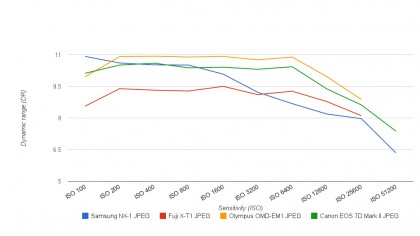Why you can trust TechRadar
We shoot a specially designed chart in carefully controlled conditions and the resulting images are analysed using DXO Analyzer software to generate the data to produce the graphs below.
The other rival cameras we chose for this comparison are the Fuji X-T1, Olympus OM-D E-M1 and Canon 7D Mark II.
A high signal to noise ratio (SNR) indicates a cleaner and better quality image.
For more more details on how to interpret our test data, check out our full explanation of our noise and dynamic range tests.
JPEG signal to noise ratio

Analysis: All four cameras produce similar results, although the Samsung's figures do take a bit of a dip in the low-medium ISO range.
Raw (converted to TIFF) signal to noise ratio

Analysis: The raw data shows a little more differentiation. The Canon 7D Mark II is the best performer here, while the Fuji X-T1, Olympus OM-D E-M1 and Samsung NX1 trail very slightly behind.
JPEG dynamic range

Analysis: It's the Olympus and the Canon that come out on top in this test, and although the NX1 keeps pace up to around ISO 800, it tails away after that.
Sign up for breaking news, reviews, opinion, top tech deals, and more.
Raw (converted to TIFF) dynamic range

Analysis: The Olympus is the clear winner here, especially at high ISOs. Of the rest, the Samsung is the best up to around ISO 3200, then falls back in line with the others.
Current page: Noise and dynamic range
Prev Page Image quality and resolution Next Page Sensitivity and noise images